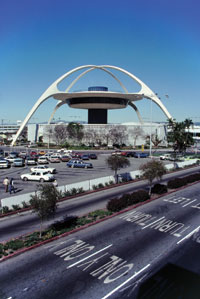 California
California
The current economic disruption will give rise to revolutionary new ideas regarding, among other things, the environment, biotechnology, business organization, and the role of government. And, the beautiful thing about good ideas is that they are free and reusable and therefore benefit all of humanity. Many believe that most of those ideas will come from
Governor Schwarzenegger often refers to
Manufacturing Returning to Our Shores?
According to the California Economic Strategy Panel, as a result of rising transportation costs and wage inflation at manufacturing centers abroad, some U.S. manufacturers are bringing production back home - and California is well positioned to benefit from such a trend. Even as manufacturing in the rest of the country was scaling back in the 1970s and 1980s, Los Angeles’ thriving container port made the region an advantageous location for manufacturing; subsequently, direct foreign investment in manufacturing is now increasing in Los Angeles. The following two examples, American Apparel and Tesla Motors, serve as case studies of new manufacturing in California:
American Apparel has proven that even clothing can be profitably manufactured in downtown Los Angeles. American Apparel is the largest clothing manufacturer in the United States. Since its founding in 2003, the company has grown to 143 stores in 11 countries with sales estimated at $300 million in 2006. A core feature of the company’s success is its ability to respond quickly to new fashion trends, and this is made possible by its location in Los Angeles. Employees are paid based on performance and above minimum wage; benefits include healthcare, English lessons, and subsidized meals.
Tesla Motors, headquartered in San Carlos, California, is one of several California companies that produce fully electric and hybrid cars. Tesla currently produces the roadster in England and has other locations in Taiwan and a technical research facility in Michigan. When considering the production location for the new sedan, Tesla chose California. Costs did play a factor in the location decision, and, while Tesla originally considered New Mexico, incentives from the State of California tipped the balance.
 In addition, after years of manufacturing parts in China, CP Lab Safety in Novato and Impco Technologies in Santa Ana have begun transferring most of its tool and die work back to California. According to CP Lab President Kelly Farhangi, shifting global economics now make it more feasible for small- and mid-size companies to use local manufacturers. Both companies cited concerns about quality and rising labor, transportation, and supply and inspection costs in Asia. In some cases, these costs have increased four fold in the last few years. Impco even offers technical and business support to small companies who want to contract with them
In addition, after years of manufacturing parts in China, CP Lab Safety in Novato and Impco Technologies in Santa Ana have begun transferring most of its tool and die work back to California. According to CP Lab President Kelly Farhangi, shifting global economics now make it more feasible for small- and mid-size companies to use local manufacturers. Both companies cited concerns about quality and rising labor, transportation, and supply and inspection costs in Asia. In some cases, these costs have increased four fold in the last few years. Impco even offers technical and business support to small companies who want to contract with them
Emerging Green Economy
Clean technology, which has been fueled by revolutionary technological advances, is dramatically transforming our economy. The growth from the Silicon Valley’s technology boom is reminiscent of the growth San Francisco experienced during the Gold Rush.
Clean-technology businesses are getting venture capital dollars and hiring new employees at a time when other segments of the economy are lagging. Recent studies show that technological progress is now responsible for up to one-half of the growth of the U.S. economy. Over the past years, investment in clean technology has soared. California clean-tech companies have benefited from this surge, receiving more investment in clean technology than anywhere else in the country. In addition, California’s business- and green-friendly atmosphere and global leadership continues to attract cutting-edge companies to our state – green business establishments in the state have grown by 84 percent and employment has doubled since 1990.
Additionally, the State continues to establish programs that will promote clean-tech growth such as the Green Collar Jobs Council (which addresses the emerging workforce needs associated with our budding green economy) and the Zero Emission Vehicle Incentive (which waives the sales tax on investment in new manufacturing equipment for zero emission vehicles). The State’s commitment to making California cleaner and greener is spurring growth in the clean-tech sector and creating green jobs.
A Bright Future
The state attracts talent from around the globe to work in its companies and study at its universities creating enduring connections between the state and other countries. The discovery process is bringing growing numbers of researchers together from across borders as evidenced in co-patenting  activity between Californians and non-U.S. residents. Foreign firms establish affiliates in California and the state’s firms open up shops abroad as well. Finally, venture capital investment flows both to and from California.
activity between Californians and non-U.S. residents. Foreign firms establish affiliates in California and the state’s firms open up shops abroad as well. Finally, venture capital investment flows both to and from California.
Economic disruptions, as we are experiencing now, challenge the status quo and offer new opportunities for businesses and the emergence of new business models. Rising transportation costs, the falling U.S. dollar, and rising incomes outside the U.S. have helped buffer the blows of the slowing economy. As a global center of innovation, California attracts companies from all over the world as a profitable location for their R&D operations. Further, new concerns about pollution and climate change are creating new opportunities for California’s green technology producers and service providers.
The State also understands it must be proactive to further promote a positive business environment in California. For this reason, Governor Schwarzenegger negotiated an economic stimulus package in this year’s budget to enhance California’s business environment while helping businesses weather this difficult economy. The budget includes provisions such as the elective single sales factor, helping level the tax playing field for California businesses; the “new hire” tax credit, rewarding California businesses who are hiring when we need it most; and streamlining the California Environmental Quality Act permitting standards, expediting projects and generating jobs.
As the United States struggles with the unfolding global economic crisis, California, with its powerful incubating industry clusters, is helping America regain its leadership position in the global economy. For companies seeking locations that will ensure that they lead in a global economy and who value creativity, persistence and optimism, there is only one choice – California.
